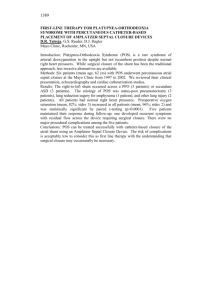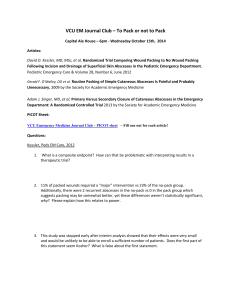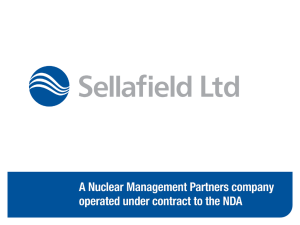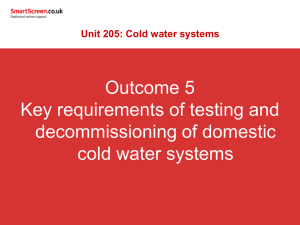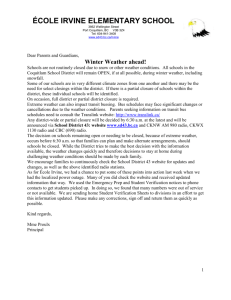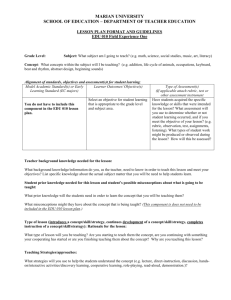Site Closure Plan Document C10
advertisement
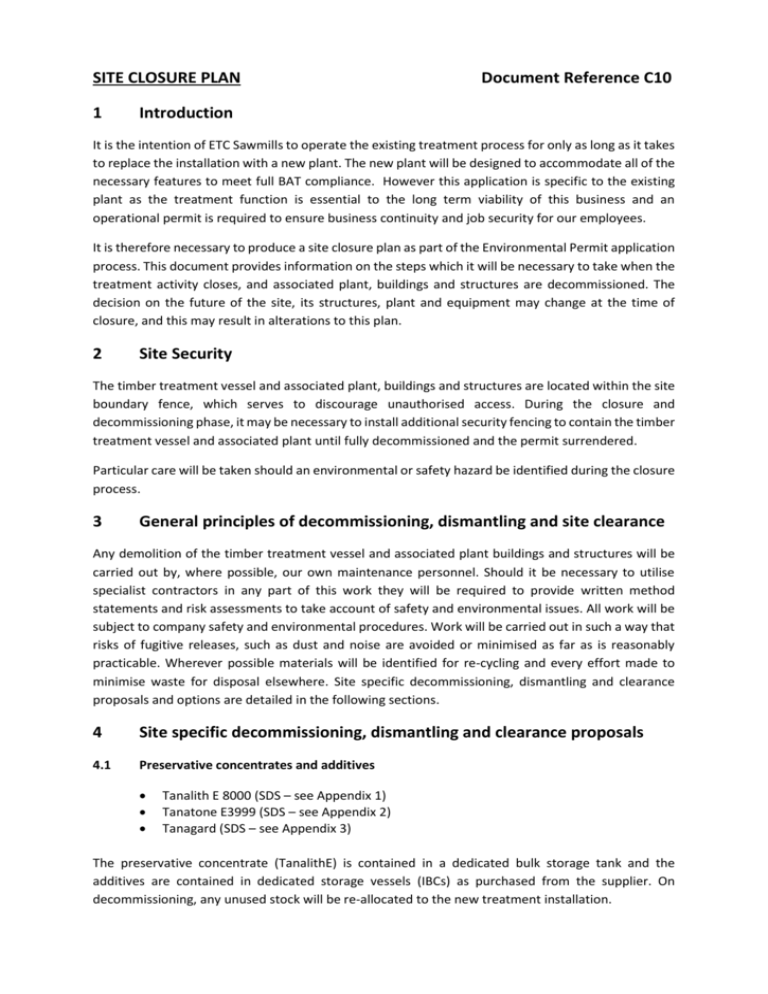
SITE CLOSURE PLAN 1 Document Reference C10 Introduction It is the intention of ETC Sawmills to operate the existing treatment process for only as long as it takes to replace the installation with a new plant. The new plant will be designed to accommodate all of the necessary features to meet full BAT compliance. However this application is specific to the existing plant as the treatment function is essential to the long term viability of this business and an operational permit is required to ensure business continuity and job security for our employees. It is therefore necessary to produce a site closure plan as part of the Environmental Permit application process. This document provides information on the steps which it will be necessary to take when the treatment activity closes, and associated plant, buildings and structures are decommissioned. The decision on the future of the site, its structures, plant and equipment may change at the time of closure, and this may result in alterations to this plan. 2 Site Security The timber treatment vessel and associated plant, buildings and structures are located within the site boundary fence, which serves to discourage unauthorised access. During the closure and decommissioning phase, it may be necessary to install additional security fencing to contain the timber treatment vessel and associated plant until fully decommissioned and the permit surrendered. Particular care will be taken should an environmental or safety hazard be identified during the closure process. 3 General principles of decommissioning, dismantling and site clearance Any demolition of the timber treatment vessel and associated plant buildings and structures will be carried out by, where possible, our own maintenance personnel. Should it be necessary to utilise specialist contractors in any part of this work they will be required to provide written method statements and risk assessments to take account of safety and environmental issues. All work will be subject to company safety and environmental procedures. Work will be carried out in such a way that risks of fugitive releases, such as dust and noise are avoided or minimised as far as is reasonably practicable. Wherever possible materials will be identified for re-cycling and every effort made to minimise waste for disposal elsewhere. Site specific decommissioning, dismantling and clearance proposals and options are detailed in the following sections. 4 Site specific decommissioning, dismantling and clearance proposals 4.1 Preservative concentrates and additives Tanalith E 8000 (SDS – see Appendix 1) Tanatone E3999 (SDS – see Appendix 2) Tanagard (SDS – see Appendix 3) The preservative concentrate (TanalithE) is contained in a dedicated bulk storage tank and the additives are contained in dedicated storage vessels (IBCs) as purchased from the supplier. On decommissioning, any unused stock will be re-allocated to the new treatment installation. 4.2 Water Harvested rainwater will be transferred to the new installation for use to make up the treatment working solutions. Pipework modifications will be made to divert the mains supply to the new plant. 4.3 Bulk storage tanks Bulk storage tanks, including mixing tanks and recovered water tanks will be safely drained and flushed to minimise preservative residues prior to their removal. The drained contents of the tanks will be transferred to the new plant for use in working solutions. Where possible, tanks will be reused on the new plant or otherwise removed from site. 4.4 Process pipework Any redundant pipework will be safely drained and flushed to minimise preservative residues prior to their removal. The drained contents of the pipework will be transferred to the new plant for use in the working solutions. Pipework will be removed from site if not suitable for use elsewhere. 4.5 Process vessels The process vessel will be drained and cleaned prior to decommissioning. The drained contents of the process vessels will be transferred to the new plant for use in the working solutions. The process vessels will be investigated for possible reuse elsewhere or otherwise removed from site. 4.6 Oils Serviceable oils will be drained from equipment removed from site for recycling. Waste oil and oil contaminated materials (filters, rags, etc.) will be removed from site by a licensed contractor and disposed of in an approved manner. 4.7 Air compressors Compressed air systems will be isolated at suitable terminal points. Compressors will be removed and either reused, recycled or disposed of. All compressed air pipework, including air receivers will be depressurised and drained prior to dismantling and removal. 4.8 Buildings & structures Currently it is anticipated that the buildings will be retained and refurbished and the bund areas filled in and concreted over for use as sawn timber storage. 4.9 Electrical systems Electrical switchgear isolations will be carried out at the terminal points as advised by our Electrical Contractor. Electrical switchgear isolations will be carried out in accordance with necessary safety rule precautions. Medium and low voltage cabling (including cable ducting, tray work, earth/ground connections etc.) will be disconnected and removed following the above isolations. Plant protection (control and instrumentation) isolations will be carried out in accordance with safety rules. Cabling (including cable ducting, tray work, earth/ground connections etc.) will be disconnected and removed observing the necessary safety rule precautions. Control and Instrumentation isolations will be carried out observing safety rules precautions. Cabling (including cable ducting, tray work, earth/ground connections etc.) will be disconnected and removed observing the necessary safety rule precautions. All control panels, switchgear, etc. will be disconnected from their connected cabling according to a pre-determined schedule and the necessary safety rule precautions observed. Panels and cabling will be considered for re-use or recycling prior to considering as scrap material. Waste electrical & electronic equipment will be reused wherever possible & disposed as waste (in compliance with the WEEE Regulations) as a last resort. 4.10 Concrete bunds Concrete bunds will filled in to ground level and it is anticipated that they will be used for sawn timber storage. 4.11 Concrete surfaces Concrete surfaces will remain in place. 5 Plan updates This plan will be maintained to demonstrate that, in its current state, the installation can be decommissioned to avoid any pollution risk and return the site of operation to a satisfactory state. This plan will be kept updated as material changes occur and will be reviewed accordingly. Material changes include: 5.1 Changes to the activity Where there have been changes to the installation affecting the boundary, the site boundary plan will be re-drawn. Where there have been changes to the activity that fundamentally affect the site closure plan, for example a change to the treatment chemicals, replacement treatment vessel, new or substantial building alterations, these changes and any potential for impact on the site closure plan will be recorded. Where any ‘dangerous substances’ not identified in the Application Site Condition Report have been used or produced as a result of the permitted activities these changes, and any potential for impact on the site closure plan, will be recorded. 5.2 Pollution incidents that may have had an impact on land, and their remediation All pollution incidents that may have damaged the land will be recorded. The records aim to demonstrate how pollution incidents were investigated and remedied. This will include: 5.3 Records of pollution incidents that may have impacted on land Records of their investigation and remediation Site closure planning ETC Sawmills will endeavour to ensure that a financial contingency is in place to return the site of the installation to a satisfactory state upon definitive cessation of activities.

